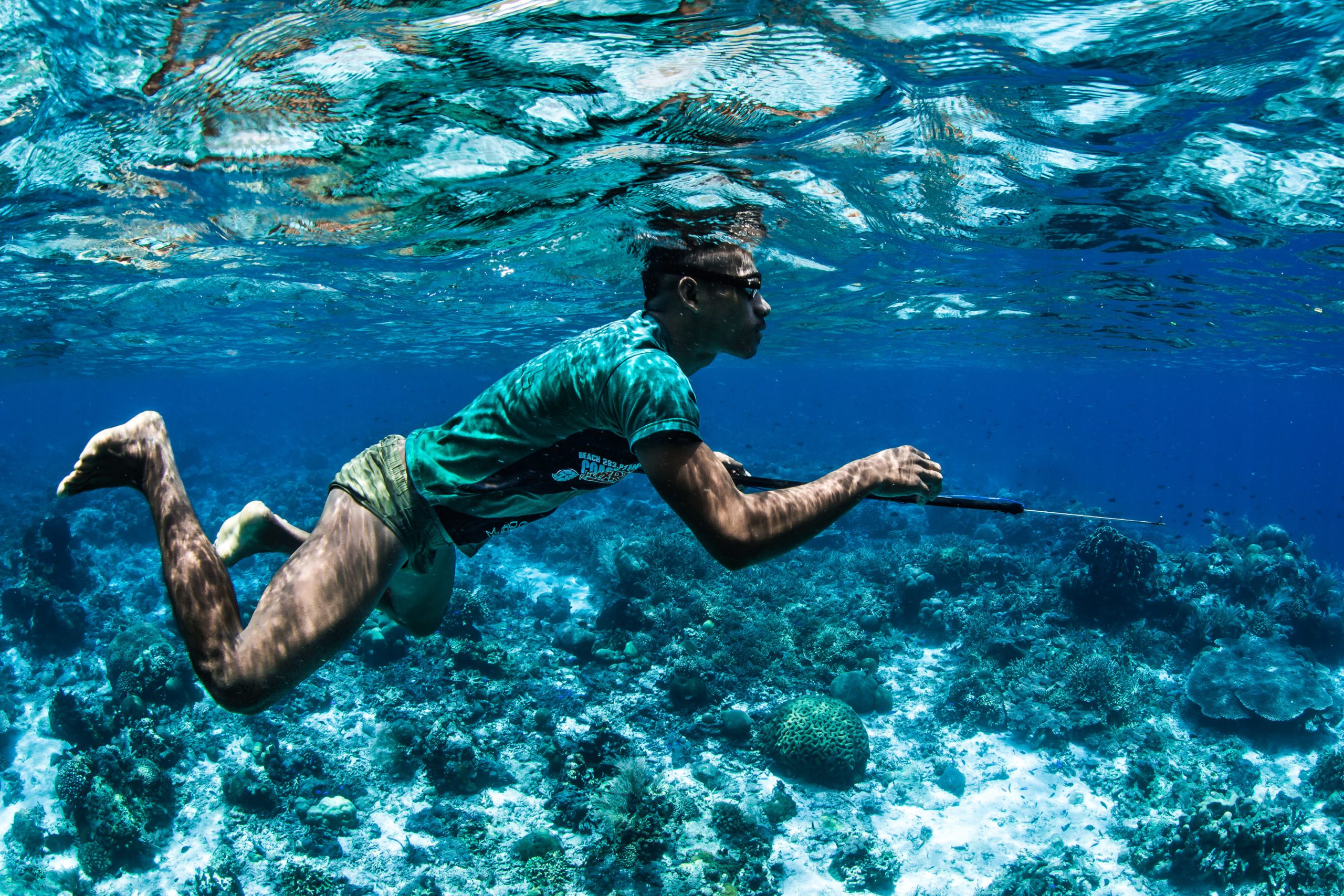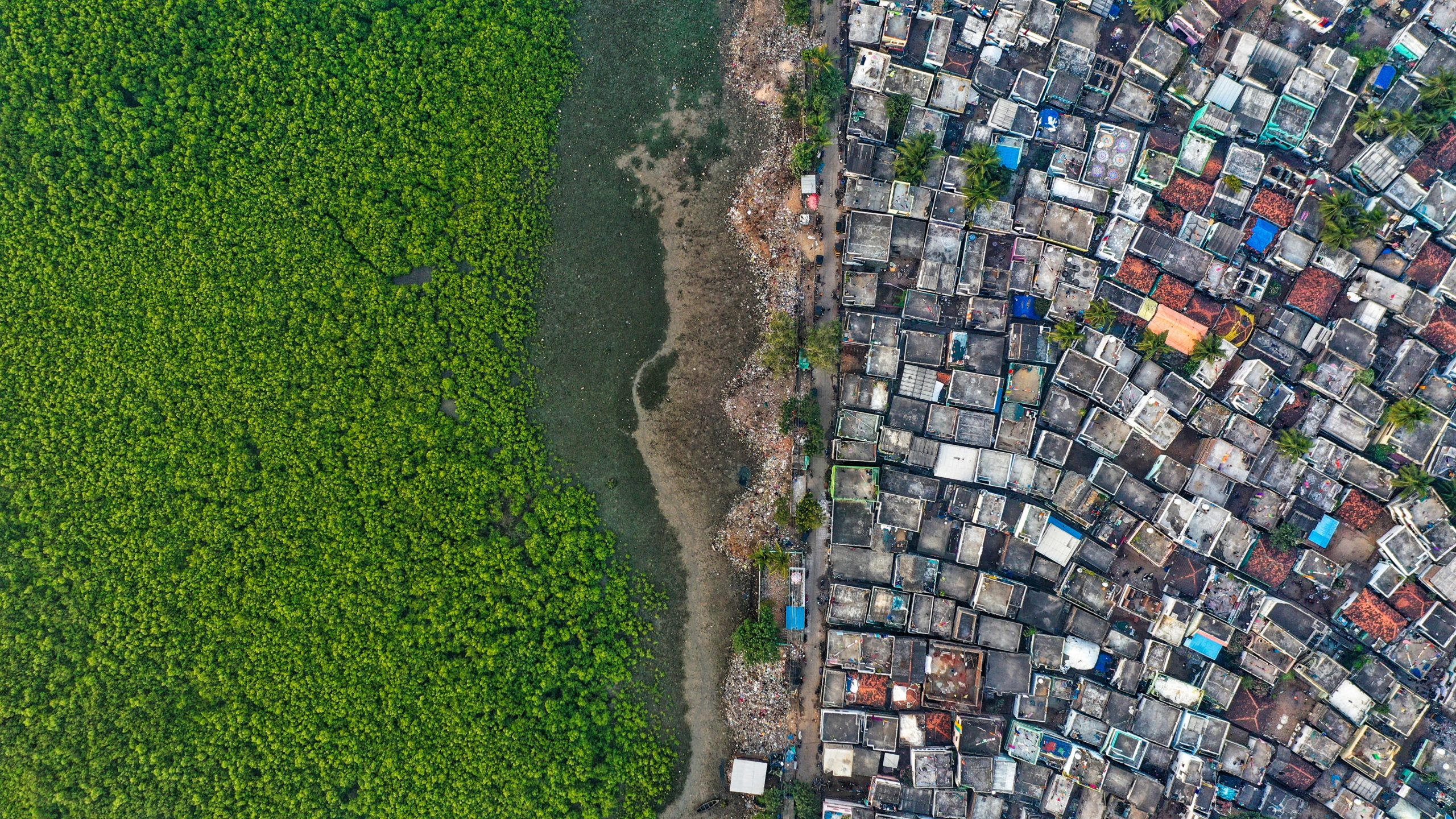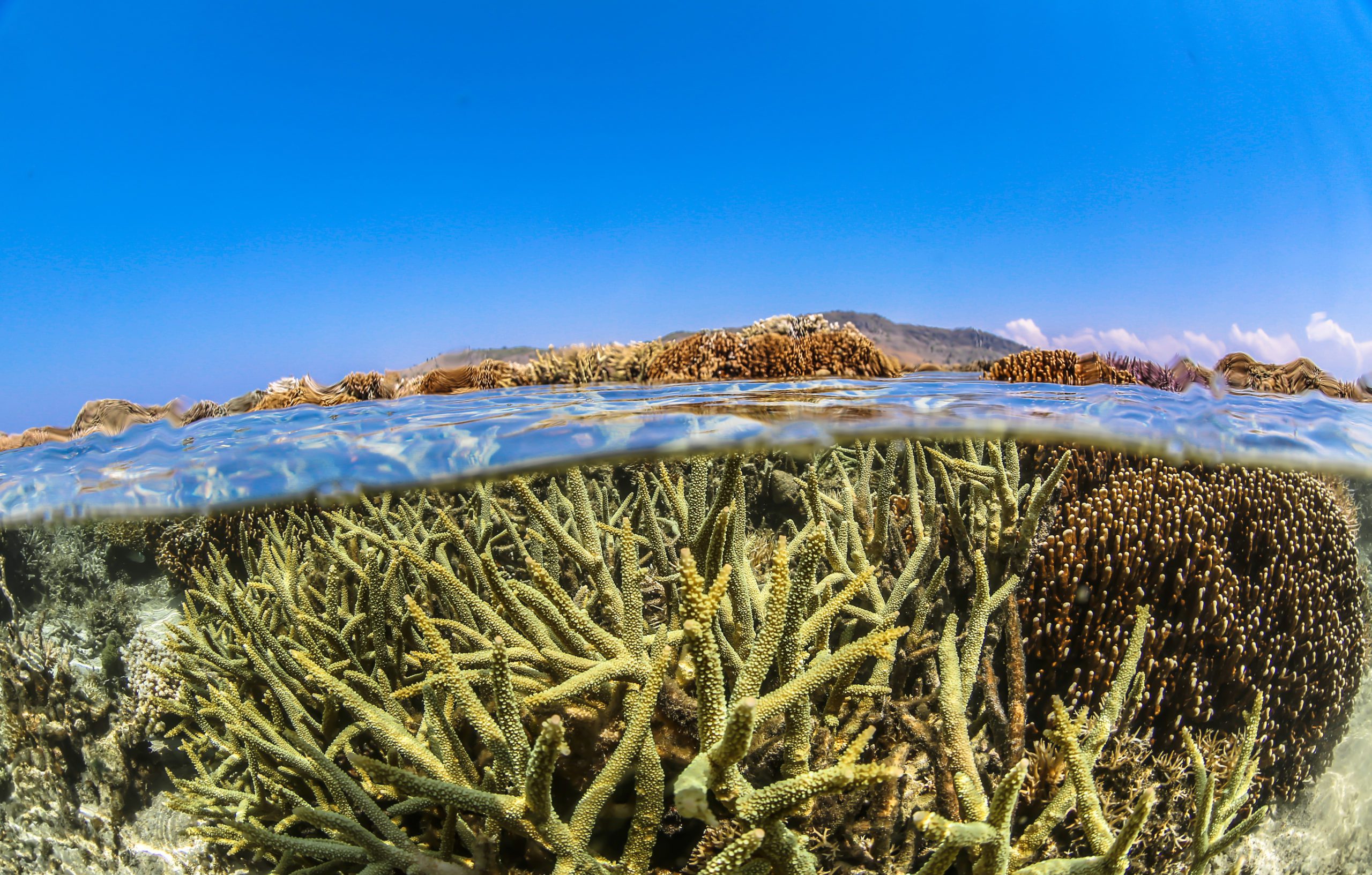
Fishing village in Tanji, The Gambia, West Africa. Photo: iStock/mariusz_prusaczyk
Summary
- Wastewater from municipal and industrial activities is an important source of coastal water pollution that is a global threat to coastal habitats and fisheries. Wastewater’s various components can have complex negative impacts on fish, affecting growth, behavior, and survival.
- Because of their proximity to coasts, nearshore fisheries and the habitats they depend on are the most vulnerable to the acute impacts of wastewater pollution.
- Wastewater pollution also threatens human health through consumption of contaminated seafood, particularly in communities that are highly dependent on seafood.
- In many cases, traditional fisheries conservation and management efforts may not be sufficient to prevent fisheries decline in the face of poor water quality.
- Solutions to wastewater pollution are available, and investments in improved wastewater treatment have benefitted coastal fisheries.
- Addressing wastewater pollution, in combination with other efforts to support and sustain vital coastal fisheries, can improve outcomes for fisheries health, food security, and human well-being.
Healthy coastal fisheries, which are crucial to coastal livelihoods and food security for billions of people worldwide, depend on good water quality.1,2
Water quality is critical to fisheries health given its impact on abundance, location, and size of fish, all of which can affect costs, fishing effort, and revenue.3 Reef-associated fishes are particularly sensitive to changes in water quality, and impaired waters can lead to declines in abundance and shifts in species composition.4 Coastal low-income countries in the tropics, women, and Indigenous communities are the most reliant on healthy nearshore fisheries and coastal habitats globally.5,6,7 In particular, small-scale fishers are one of the most vulnerable sub-groups who rely on healthy fishery resources given their high dependence on fisheries for food and livelihoods. Coastal pollution must be managed to protect these vital nearshore fisheries and the livelihoods of all those who depend on them.
Wastewater is a key threat to coastal water quality globally.
“Wastewater” is a term that refers to used water and can encompass a variety of pollutants, including those originating from residential, commercial, and industrial uses as well as urban stormwater runoff.8,9 Sewage (wastewater from municipal sources) is a significant part of wastewater in many cases, and is a major driver of coastal ecosystem impacts. Sewage itself can contain nutrients, organic matter, bacteria, viruses, parasites, pharmaceuticals, endocrine disruptors, micro and macro plastics, industrial chemicals, sediments, and heavy metals. Sewage makes up the greatest volume of waste released into the marine and coastal environment, posing significant threats to nearshore fishery habitat and health.10 While wastewater treatment plants have become more efficient in removing many contaminants, they are not designed to filter everything.11 Coastal fisheries and shellfish are exposed to an array of land-based pollutants through the discharge of wastewater and sewage into the ocean, including nutrients, endocrine disruptors, pathogens, heavy metals, and other toxins.12 Pollutants discharged into coastal waters can travel more than 100 miles from land and disperse into adjacent waters, which can affect entire fisheries and coral reefs.13,14 A recent global review revealed that sewage is polluting nearly every coral reef geography around the world.15
Pollutants discharged into coastal waters can travel more than 100 miles from land and disperse into adjacent waters, which can affect entire fisheries and coral reefs.
Wastewater’s various components can have complex negative impacts on fish, affecting growth, behavior, and survival.
Since the early 1900s, research has shown that fish exposed to various chemicals and pollutants develop altered behavior and growth.16 Not only can individual pollutants stress fishes in unique ways, but the combination of multiple pollutants can compound the effects.17,18 Pollutants found in wastewater can affect the growth, development, and survival of fishes in the following ways:
- Nutrients, in excess amounts, can trigger algal blooms, which reduce critical dissolved oxygen and eventually trigger mass marine life die-offs. Not only that, but the toxins produced by harmful algal blooms can contaminate nearshore fisheries, resulting in fisheries closures and significant economic losses.19 About 80 percent of large marine ecosystems globally are experiencing coastal eutrophication and depleted oxygen.20
- Sediments and suspended solids can smother plants and animals, and are associated with declines in species diversity and abundance, with coral reef ecosystems especially threatened.21 Evidence shows that increased suspended sediment impairs survival of coral reef fishes and may compound the threat of habitat loss.22
- Bacteria, viruses, and parasites are commonly found in wastewater discharge, and many of the same viruses and bacteria that infect humans can also infect marine life, including corals.23,24
- Pharmaceuticals and other drugs entering waterways through wastewater effluent have been shown to uptake into nearshore fisheries, though the extent of their impacts on fish growth, development, and survival is still being researched.25 Alarmingly, fish have even been shown to develop signs of drug addiction and associated behavior change from illegal drugs entering waterways through wastewater.26
- Endocrine disruptors have been demonstrated to permanently alter fish reproductive systems as a result of long-term effluent exposure.27,28
- Microplastics, including microfibers, largely enter our waterways through wastewater and can attract and absorb high levels of toxic pollutants.29 While the impacts of these plastics on fish growth, reproduction, and survival (as well as the health of humans consuming them) are still being studied, microplastics are already prevalent in seafood: one study demonstrated that a quarter of all fish sampled from markets in California and Indonesia contained plastics or human-made debris.30

Spearfisher in Alor, Indonesia. Photo: Erik Lukas / Ocean Image Bank
Because of their proximity to coasts, nearshore fisheries and the habitats they depend on are the most vulnerable to the acute impacts of wastewater pollution.
Research continues to reveal how wastewater affects nearshore fisheries and habitat. Fish found near coastal wastewater outfalls have been shown to retain staggering numbers of contaminants found in wastewater.31 One study determined that the tissues of juvenile Chinook salmon and Pacific staghorn sculpin found near outfalls contained 42 different sewage contaminants.32 Wastewater affects not only nearshore fish themselves, but also their environment and environmental conditions. Coastal coral reef fisheries in the tropics have been shown to be particularly vulnerable to sewage pollutants.33 On top of that, sewage pollution threatens the coral species that support valuable coral reef fisheries.34 Salt marshes and mangroves, which are vital habitat for juvenile fisheries, are also becoming more vulnerable as a result of nutrient pollution, with additional implications for economic growth and food production.35,36,37 Seagrasses, which serve as nurseries and feeding grounds for a number of commercial fisheries, including over one-fifth of the 25 largest fisheries in the world, are declining because of nutrients and sediments from land-based pollution, including wastewater.38,39 Nearly a third of seagrasses have been lost since the late 1800s, and rates of loss have accelerated.40 While research continues to emerge clarifying the impacts of wastewater pollution on nearshore fisheries and their habitats, the extent of contamination may already be substantial.41

Mangroves and development. Photo: Srikanth Mannepuri / Ocean Image Bank
Wastewater pollution also threatens human health through consumption of contaminated seafood, particularly in communities that are highly dependent on seafood.
Seafood is a leading source of foodborne illness worldwide, with coastal urbanization and associated pollution identified as one of the leading causes of increased seafood contamination.42 In the U.S., sewage is the most common seafood contaminant.43 In addition, the nutrients from wastewater can cause harmful algal blooms. The toxins from those blooms can harm human health both through direct exposure and through consumption of seafood contaminated with toxic algae.44 Human populations bear unequal risk of exposure to these contaminants. Evidence suggests fish landed from shore, where minority and low-income anglers are more likely to fish, often have higher concentrations of pollutants.45 The risk of contamination is even more severe in low-income coastal nations where wastewater infrastructure is limited or nonexistent and where communities consume more seafood. For example, coastal Indigenous communities worldwide consume on average 15 times more seafood per capita than non-Indigenous populations.46 Wastewater pollution is a direct threat to the fisheries and habitat that some coastal Indigenous peoples depend on.47
In many cases, traditional fisheries conservation and management efforts may not be sufficient to prevent decline in the face of poor water quality.
The effects of chronic pollution on fisheries may be long lasting, via degradation of nursery areas and key habitats, loss of biodiversity, changes to fish reproductive viability, and even direct contributions to fish mortality.48 Many fishery managers are unable to address pollution as a result of jurisdictional and legal barriers. As a result, fisheries decline caused by pollution will continue, even if managers use many of the population management tools at their disposal.49 As a co-author of a study on eutrophication on the Belize Barrier Reef, Brian Lapointe, commented,
Our latest data provide further evidence that it is unlikely that simply controlling fishing practices, even in light of climate change, will enhance resilience of Belize’s coral reefs or any other coral reefs being impacted by eutrophication. The reality of this large-scale coastal pollution must be rigorously confronted by scientists and resource managers alike in Belize, the United States and world-wide.50
Addressing water quality can not only ensure the success of marine conservation and coastal livelihoods protection work, but also improve the resilience of critical marine ecosystems, such as coral reefs, to the impacts of climate change.51
Solutions to wastewater pollution are available, and investments in improved wastewater treatment have benefitted coastal fisheries.
For example, after an attempt to restore severely diminished fisheries in the Great South Bay of Long Island failed because of persistent algal blooms, scientists went to work to address underlying water quality conditions and understand their causes.52 Modeling efforts revealed that septic systems were responsible for 70 to 80 percent of the nitrogen pollution in the Great South Bay, and 370,000 local households relied on on-site wastewater treatment systems that, even when fully functioning, did not remove nutrients.53 Investments in septic system upgrades and wastewater treatment plant upgrades now prevent more than 25,000 pounds of nitrogen from sewage from entering coastal waters annually.54 Another example is that of West Hawaii, where fish biomass on important coral reefs was found to have declined by 45 percent over 10 years, primarily influenced by increasing sewage pollution.55 The Puakō coast is adjacent to ecologically and economically important reefs that provide habitat to culturally significant species.56 The local community of Puakō was estimated to be contributing around 600,000 gallons of untreated sewage into the environment daily.57 After nearly a decade of research and collaboration, the Puakō community and Hawaiian government have agreed on a sewage treatment plan that will, when implemented, substantially reduce sewage entering the environment.58

Coral reef, Indonesia. Photo: OceanImageBank / Martin Colognoli
Addressing wastewater pollution, in combination with other efforts to support and sustain vital coastal fisheries, can improve outcomes for fisheries health, food security, and human well-being.
Coastal communities may be more reliant on healthy fisheries than ever before, as global demand for fisheries and coastal resources is only growing.59 Yet low-income coastal communities that struggle with managing water quality and lack efficient wastewater infrastructure often overlap with those most dependent on the coastal ecosystems and resources threatened by pollution. Wastewater and sewage pollution are solvable threats, though philanthropy has largely neglected this important intersection of human and environmental health, and the area remains significantly underfunded relative to other ocean threats. Solutions include investing in upgrades to wastewater treatment plants and onsite wastewater treatment solutions, support for community water quality monitoring, innovative low-cost sewage treatment systems, and policies that both regulate acceptable levels of contaminants and incentivize their removal (through nutrient-credit trading systems). These investments can support healthy marine ecosystems, sustain economically viable and productive coastal fisheries, and protect human health.
Notes
- Sale, Peter F., Tundi Agardy, Cameron H. Ainsworth, Blake E. Feist, Johann D. Bell, Patrick Christie, Ove Hoegh-Guldberg, et al. “Transforming Management of Tropical Coastal Seas to Cope with Challenges of the 21st Century.” Marine Pollution Bulletin 85, no. 1 (August 15, 2014): 8–23. https://doi.org/10.1016/j.marpolbul.2014.06.005.
- Evans, Keith S., Kevin Athearn, Xuan Chen, Kathleen P. Bell, and Tora Johnson. “Measuring the Impact of Pollution Closures on Commercial Shellfish Harvest: The Case of Soft-Shell Clams in Machias Bay, Maine.” Ocean & Coastal Management 130 (2016): 196–204. https://doi.org/10.1016/j.ocecoaman.2016.06.005.
- Evans, Keith S., Kevin Athearn, Xuan Chen, Kathleen P. Bell, and Tora Johnson. “Measuring the Impact of Pollution Closures on Commercial Shellfish Harvest: The Case of Soft-Shell Clams in Machias Bay, Maine.” Ocean & Coastal Management 130 (2016): 196–204. https://doi.org/10.1016/j.ocecoaman.2016.06.005.
- Wenger, Amelia S., Mark I. McCormick, Geoffrey G. K. Endo, Ian M. McLeod, Frederieke J. Kroon, and Geoffrey P. Jones. “Suspended Sediment Prolongs Larval Development in a Coral Reef Fish.” Journal of Experimental Biology 217, no. 7 (April 1, 2014): 1122–28. https://doi.org/10.1242/jeb.094409.
- Golden, Christopher D., Edward H. Allison, William W. L. Cheung, Madan M. Dey, Benjamin S. Halpern, Douglas J. McCauley, Matthew Smith, Bapu Vaitla, Dirk Zeller, and Samuel S. Myers. “Nutrition: Fall in Fish Catch Threatens Human Health.” Nature 534, no. 7607 (June 2016): 317–20. https://doi.org/10.1038/534317a.
- Harper, Sarah, Dirk Zeller, Melissa Hauzer, Daniel Pauly, and Ussif Rashid Sumaila. “Women and Fisheries: Contribution to Food Security and Local Economies.” Marine Policy 39 (May 1, 2013): 56–63. https://doi.org/10.1016/j.marpol.2012.10.018.
- Cisneros-Montemayor, Andrés M., Daniel Pauly, Lauren V. Weatherdon, and Yoshitaka Ota. “A Global Estimate of Seafood Consumption by Coastal Indigenous Peoples.” PLOS ONE 11, no. 12 (December 5, 2016): e0166681. https://doi.org/10.1371/journal.pone.0166681.
- Reef Resilience Network. “Wastewater Pollution Introduction.” https://reefresilience.org/wastewater-pollution/wastewater-pollution-introduction/.
- Jambeck, Jenna, Ellie Moss, Brajesh Dubey, Zainal Arifin, Linda Godfrey, Britta Denise Hardesty, I Gede Hendrawan, et al. “Leveraging Multi-Target Strategies to Address Plastic Pollution in the Context of an Already Stressed Ocean.” Washington DC: World Resources Institute, 2020.
- Shahidul Islam, Md., and Masaru Tanaka. “Impacts of Pollution on Coastal and Marine Ecosystems Including Coastal and Marine Fisheries and Approach for Management: A Review and Synthesis.” Marine Pollution Bulletin 48, no. 7 (April 1, 2004): 624–49. https://doi.org/10.1016/j.marpolbul.2003.12.004.
- Horký, Pavel, Roman Grabic, Kateřina Grabicová, Bryan W. Brooks, Karel Douda, Ondřej Slavík, Pavla Hubená, Eugenia M. Sancho Santos, and Tomáš Randák. “Methamphetamine Pollution Elicits Addiction in Wild Fish.” Journal of Experimental Biology 224, no. 13 (July 6, 2021). https://doi.org/10.1242/jeb.242145.
- Reef Resilience Network. “Impacts on Marine Life.” https://reefresilience.org/wastewater-pollution/impacts-on-marine-life/.
- Burke, Lauretta, Katie Reytar, Mark Spalding, and Allison Perry. “Reefs at Risk Revisited.” Washington, DC: World Resources Institute, February 23, 2011. https://www.wri.org/research/reefs-risk-revisited.
- Shore, Amanda, Jordan A. Sims, Michael Grimes, Lauren I. Howe-Kerr, Carsten G. B. Grupstra, Shawn M. Doyle, Lauren Stadler, et al. “On a Reef Far, Far Away: Anthropogenic Impacts Following Extreme Storms Affect Sponge Health and Bacterial Communities.” Frontiers in Marine Science 0 (2021). https://doi.org/10.3389/fmars.2021.608036.
- Wear, Stephanie, and Rebecca Vega Thurber. “Sewage Pollution: Mitigation Is Key for Coral Reef Stewardship: Sewage Pollution and Coral Reef Stewardship.” Annals of the New York Academy of Sciences 1355 (May 8, 2015). https://doi.org/10.1111/nyas.12785.
- Ford, Alex T., Marlene Ågerstrand, Bryan W. Brooks, Joel Allen, Michael G. Bertram, Tomas Brodin, ZhiChao Dang, et al. “The Role of Behavioral Ecotoxicology in Environmental Protection.” Environmental Science & Technology 55, no. 9 (May 4, 2021): 5620–28. https://doi.org/10.1021/acs.est.0c06493.
- Jambeck, Jenna, Ellie Moss, Brajesh Dubey, Zainal Arifin, Linda Godfrey, Britta Denise Hardesty, I Gede Hendrawan, et al. “Leveraging Multi-Target Strategies to Address Plastic Pollution in the Context of an Already Stressed Ocean.” Washington DC: World Resources Institute, 2020.
- Wear, Stephanie, and Rebecca Vega Thurber. “Sewage Pollution: Mitigation Is Key for Coral Reef Stewardship: Sewage Pollution and Coral Reef Stewardship.” Annals of the New York Academy of Sciences 1355 (May 8, 2015). https://doi.org/10.1111/nyas.12785.
- Moore, Stephanie K., Michael R. Cline, Kathryn Blair, Terrie Klinger, Anna Varney, and Karma Norman. “An Index of Fisheries Closures Due to Harmful Algal Blooms and a Framework for Identifying Vulnerable Fishing Communities on the U.S. West Coast.” Marine Policy 110 (December 1, 2019): 103543. https://doi.org/10.1016/j.marpol.2019.103543.
- Jambeck, Jenna, Ellie Moss, Brajesh Dubey, Zainal Arifin, Linda Godfrey, Britta Denise Hardesty, I Gede Hendrawan, et al. “Leveraging Multi-Target Strategies to Address Plastic Pollution in the Context of an Already Stressed Ocean.” Washington DC: World Resources Institute, 2020.
- Wenger, Amelia S., Mark I. McCormick, Geoffrey G. K. Endo, Ian M. McLeod, Frederieke J. Kroon, and Geoffrey P. Jones. “Suspended Sediment Prolongs Larval Development in a Coral Reef Fish.” Journal of Experimental Biology 217, no. 7 (April 1, 2014): 1122–28. https://doi.org/10.1242/jeb.094409.
- Wenger, Amelia S., J. L. Johansen, and G. P. Jones. “Suspended Sediment Impairs Habitat Choice and Chemosensory Discrimination in Two Coral Reef Fishes.” Coral Reefs 30, no. 4 (December 1, 2011): 879–87. https://doi.org/10.1007/s00338-011-0773-z.
- Shahidul Islam, Md., and Masaru Tanaka. “Impacts of Pollution on Coastal and Marine Ecosystems Including Coastal and Marine Fisheries and Approach for Management: A Review and Synthesis.” Marine Pollution Bulletin 48, no. 7 (April 1, 2004): 624–49. https://doi.org/10.1016/j.marpolbul.2003.12.004.
- Sutherland, Kathryn Patterson, Sameera Shaban, Jessica L. Joyner, James W. Porter, and Erin K. Lipp. “Human Pathogen Shown to Cause Disease in the Threatened Eklhorn Coral Acropora Palmata.” PLOS ONE 6, no. 8 (August 17, 2011): e23468. https://doi.org/10.1371/journal.pone.0023468.
- Ehrhart, Amy L., and Elise F. Granek. “Pharmaceuticals and Alkylphenols in Transplanted Pacific Oysters (Crassostrea Gigas): Spatial Variation and Growth Effects.” Marine Pollution Bulletin 170 (September 2021): 112584. https://doi.org/10.1016/j.marpolbul.2021.112584.
- Horký, Pavel, Roman Grabic, Kateřina Grabicová, Bryan W. Brooks, Karel Douda, Ondřej Slavík, Pavla Hubená, Eugenia M. Sancho Santos, and Tomáš Randák. “Methamphetamine Pollution Elicits Addiction in Wild Fish.” Journal of Experimental Biology 224, no. 13 (July 6, 2021). https://doi.org/10.1242/jeb.242145.
- Liney, Katherine E., Josephine A. Hagger, Charles R. Tyler, Michael H. Depledge, Tamara S. Galloway, and Susan Jobling. “Health Effects in Fish of Long-Term Exposure to Effluents from Wastewater Treatment Works.” Environmental Health Perspectives 114, no. Suppl 1 (2006): 81–89. https://doi.org/10.1289/ehp.8058.
- Jobling, S., and C. R. Tyler. “Endocrine disruption in wild freshwater fish.” Pure and Applied Chemistry 75, no. 11–12 (January 1, 2003): 2219–34. https://doi.org/10.1351/pac200375112219.
- Seltenrich, Nate. “New Link in the Food Chain? Marine Plastic Pollution and Seafood Safety.” Environmental Health Perspectives 123, no. 2 (February 1, 2015): A34–41. https://doi.org/10.1289/ehp.123-A34.
- Rochman, Chelsea M., Akbar Tahir, Susan L. Williams, Dolores V. Baxa, Rosalyn Lam, Jeffrey T. Miller, Foo-Ching Teh, Shinta Werorilangi, and Swee J. Teh. “Anthropogenic Debris in Seafood: Plastic Debris and Fibers from Textiles in Fish and Bivalves Sold for Human Consumption.” Scientific Reports 5, no. 1 (September 24, 2015): 14340. https://doi.org/10.1038/srep14340.
- Meador, James P., Andrew Yeh, Graham Young, and Evan P. Gallagher. “Contaminants of Emerging Concern in a Large Temperate Estuary.” Environmental Pollution 213 (June 1, 2016): 254–67. https://doi.org/10.1016/j.envpol.2016.01.088.
- Meador, James P., Andrew Yeh, Graham Young, and Evan P. Gallagher. “Contaminants of Emerging Concern in a Large Temperate Estuary.” Environmental Pollution 213 (June 1, 2016): 254–67. https://doi.org/10.1016/j.envpol.2016.01.088.
- Wear, Stephanie, and Rebecca Vega Thurber. “Sewage Pollution: Mitigation Is Key for Coral Reef Stewardship: Sewage Pollution and Coral Reef Stewardship.” Annals of the New York Academy of Sciences 1355 (May 8, 2015). https://doi.org/10.1111/nyas.12785.
- Wear, Stephanie, and Rebecca Vega Thurber. “Sewage Pollution: Mitigation Is Key for Coral Reef Stewardship: Sewage Pollution and Coral Reef Stewardship.” Annals of the New York Academy of Sciences 1355 (May 8, 2015). https://doi.org/10.1111/nyas.12785.
- Wear, Stephanie L., Vicenç Acuña, Rob McDonald, and Carme Font. “Sewage Pollution, Declining Ecosystem Health, and Cross-Sector Collaboration.” Biological Conservation 255 (March 1, 2021): 109010. https://doi.org/10.1016/j.biocon.2021.109010.
- Deegan, Linda A., David Samuel Johnson, R. Scott Warren, Bruce J. Peterson, John W. Fleeger, Sergio Fagherazzi, and Wilfred M. Wollheim. “Coastal Eutrophication as a Driver of Salt Marsh Loss.” Nature 490, no. 7420 (2012): 388–92. https://doi.org/10.1038/nature11533.
- Lovelock, Catherine E., Marilyn C. Ball, Katherine C. Martin, and Ilka C. Feller. “Nutrient Enrichment Increases Mortality of Mangroves.” PLOS ONE 4, no. 5 (May 19, 2009): e5600. https://doi.org/10.1371/journal.pone.0005600.
- Unsworth, Richard K. F., Lina Mtwana Nordlund, and Leanne C. Cullen-Unsworth. “Seagrass Meadows Support Global Fisheries Production.” Conservation Letters 12, no. 1 (2019): e12566. https://doi.org/10.1111/conl.12566.
- Cabaço, Susana, Raquel Machás, Vasco Vieira, and Rui Santos. “Impacts of Urban Wastewater Discharge on Seagrass Meadows (Zostera Noltii).” Estuarine, Coastal and Shelf Science 78, no. 1 (June 1, 2008): 1–13. https://doi.org/10.1016/j.ecss.2007.11.005.
- Waycott, Michelle, Carlos M. Duarte, Tim J. B. Carruthers, Robert J. Orth, William C. Dennison, Suzanne Olyarnik, Ainsley Calladine, et al. “Accelerating Loss of Seagrasses across the Globe Threatens Coastal Ecosystems.” Proceedings of the National Academy of Sciences 106, no. 30 (July 28, 2009): 12377–81. https://doi.org/10.1073/pnas.0905620106.
- Wear, Stephanie L., Vicenç Acuña, Rob McDonald, and Carme Font. “Sewage Pollution, Declining Ecosystem Health, and Cross-Sector Collaboration.” Biological Conservation 255 (March 1, 2021): 109010. https://doi.org/10.1016/j.biocon.2021.109010.
- Littman, Raechel A., Evan A. Fiorenza, Amelia S. Wenger, Kathryn L. E. Berry, Jeroen A. J. M. van de Water, Lily Nguyen, Soe Tint Aung, et al. “Coastal Urbanization Influences Human Pathogens and Microdebris Contamination in Seafood.” Science of The Total Environment 736 (September 20, 2020): 139081. https://doi.org/10.1016/j.scitotenv.2020.139081.
- Institute of Medicine (US) Committee on Evaluation of the Safety of Fishery. “Microbiological and Parasitic Exposure and Health Effects.” In Seafood Safety, edited by Farid E. Ahmed. National Academies Press (US), 1991. https://www.ncbi.nlm.nih.gov/books/NBK235727/.
- Jambeck, Jenna, Ellie Moss, Brajesh Dubey, Zainal Arifin, Linda Godfrey, Britta Denise Hardesty, I Gede Hendrawan, et al. “Leveraging Multi-Target Strategies to Address Plastic Pollution in the Context of an Already Stressed Ocean.” Washington DC: World Resources Institute, 2020.
- Ross, Cooper. “The Predicament of Subsistence Fishing and Seafood Contaminants.” California Sea Grant, October 8, 2020. https://caseagrant.ucsd.edu/blogs/the-predicament-of-subsistence-fishing-and-seafood-contaminants.
- Cisneros-Montemayor, Andrés M., Daniel Pauly, Lauren V. Weatherdon, and Yoshitaka Ota. “A Global Estimate of Seafood Consumption by Coastal Indigenous Peoples.” PLOS ONE 11, no. 12 (December 5, 2016): e0166681. https://doi.org/10.1371/journal.pone.0166681.
- Cisneros-Montemayor, Andrés M., Daniel Pauly, Lauren V. Weatherdon, and Yoshitaka Ota. “A Global Estimate of Seafood Consumption by Coastal Indigenous Peoples.” PLOS ONE 11, no. 12 (December 5, 2016): e0166681. https://doi.org/10.1371/journal.pone.0166681.
- Shahidul Islam, Md., and Masaru Tanaka. “Impacts of Pollution on Coastal and Marine Ecosystems Including Coastal and Marine Fisheries and Approach for Management: A Review and Synthesis.” Marine Pollution Bulletin 48, no. 7 (April 1, 2004): 624–49. https://doi.org/10.1016/j.marpolbul.2003.12.004.
- Shahidul Islam, Md., and Masaru Tanaka. “Impacts of Pollution on Coastal and Marine Ecosystems Including Coastal and Marine Fisheries and Approach for Management: A Review and Synthesis.” Marine Pollution Bulletin 48, no. 7 (April 1, 2004): 624–49. https://doi.org/10.1016/j.marpolbul.2003.12.004.
- ScienceDaily. “What’s Killing Coral Reefs in Florida Is Also Killing Them in Belize: Study of Belize Barrier Reef Shows Nitrogen Enrichment from Land-Based Sources Doubled in Four Decades.” https://www.sciencedaily.com/releases/2021/08/210803105534.htm.
- Wooldridge, Scott A., and Terence J. Done. “Improved Water Quality Can Ameliorate Effects of Climate Change on Corals.” Ecological Applications 19, no. 6 (2009): 1492–99. https://doi.org/10.1890/08-0963.1.
- Reef Resilience Network. “New York – Wastewater Pollution.” https://reefresilience.org/case-studies/new-york-wastewater-pollution/.
- Reef Resilience Network. “New York – Wastewater Pollution.” https://reefresilience.org/case-studies/new-york-wastewater-pollution/.
- Reef Resilience Network. “New York – Wastewater Pollution.” https://reefresilience.org/case-studies/new-york-wastewater-pollution/.
- Reef Resilience Network. “Hawaii – Wastewater Pollution.” https://reefresilience.org/case-studies/hawaii-wastewater-pollution-2/.
- Reef Resilience Network. “Hawaii – Wastewater Pollution.” https://reefresilience.org/case-studies/hawaii-wastewater-pollution-2/.
- Reef Resilience Network. “Hawaii – Wastewater Pollution.” https://reefresilience.org/case-studies/hawaii-wastewater-pollution-2/.
- Reef Resilience Network. “Hawaii – Wastewater Pollution.” https://reefresilience.org/case-studies/hawaii-wastewater-pollution-2/.
- Costello, Christopher, Ling Cao, Stefan Gelcich, Miguel Á Cisneros-Mata, Christopher M. Free, Halley E. Froehlich, Christopher D. Golden, et al. “The Future of Food from the Sea.” Nature 588, no. 7836 (December 2020): 95–100. https://doi.org/10.1038/s41586-020-2616-y.
